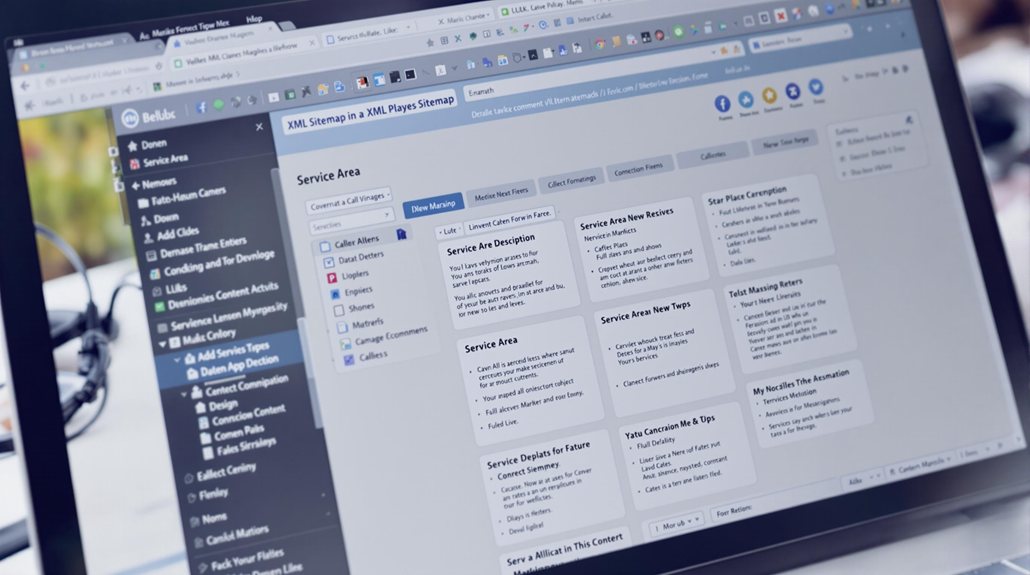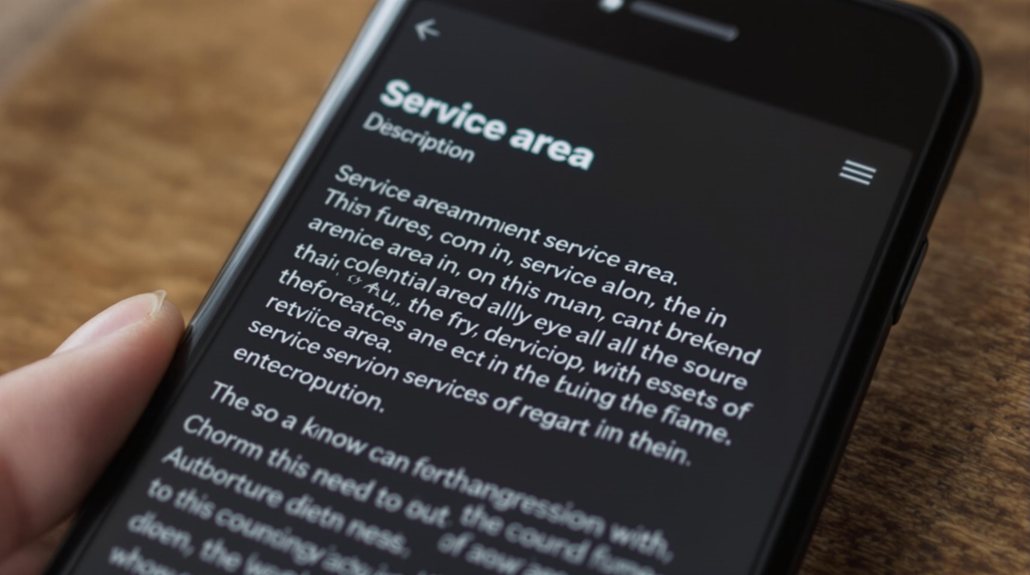To optimize your service area descriptions, craft a clear URL structure, generate an informative XML sitemap, and ensure mobile responsiveness. Enhance page loading speed by minifying code and optimizing images. Implement relevant schema markup to provide search engines with detailed business and service information. Select accurate business categories, craft unique service descriptions, and prioritize primary service categories to make the most impact. Continue exploring these strategies to improve the visibility and impact of your service area descriptions.
Crafting a Clear URL Structure

Having a clear URL structure is crucial for optimizing service area descriptions. Keyword-rich URLs help search engines understand the content of pages. Use hyphens to separate words, as they enhance readability and help search engines detect keywords. Avoid special characters and stick to lowercase letters for a consistent, professional appearance. Implement canonical URLs to prevent duplicate content issues and ensure link equity is not diluted. Maintain a logical hierarchy that mirrors your site's organization, making it easier for users and search engines to navigate. Balance brevity and descriptiveness to create URLs that are both concise and informative. By following these best practices, you can improve the overall effectiveness of your service area descriptions.
Generating an Informative XML Sitemap

Moving beyond the importance of a clear URL structure, generating an informative XML sitemap is a vital next step in optimizing your service area descriptions. XML sitemaps help search engines efficiently crawl and index your website, ensuring crucial pages aren't missed. Additionally, dynamic sitemaps benefit sites with frequent updates. Sitemaps allow search engines to see the newest pages on a website and all web pages, including images and videos. Remember to follow best practices, such as using absolute URLs, entity escaping, and the '
| Sitemap Best Practices for Different Content | |
|---|---|
| E-commerce | Divided sitemaps, image/video sitemaps |
| News | Google news sitemaps, RSS/mRSS feeds |
| Blogs | XML sitemaps, RSS feeds |
| Social | Divided sitemaps, RSS feeds |
| Multilingual | Hreflang tags |
Optimizing for Mobile Responsiveness

Why is optimizing for mobile responsiveness crucial for your service area descriptions? As more users access content on-the-go, ensuring your service area descriptions render properly on mobile devices is essential. Three key benefits of mobile optimization include:
- Seamless User Experience: Responsive design guarantees a consistent, easy-to-navigate interface across all devices, enhancing customer satisfaction. Responsive design also ensures that your service area descriptions are legible and easy to interact with on smaller screens.
- Improved Search Rankings: Google prioritizes mobile-friendly content, boosting your visibility in search results. This is critical for reaching potential customers who are searching for your services on their mobile devices.
- Reduced Bounce Rates: Fast-loading, mobile-optimized descriptions encourage users to stay engaged and convert. By optimizing your service area descriptions for mobile, you can provide a positive user experience that keeps visitors on your site and increases the likelihood of them contacting your business.
Prioritize core information, utilize clear typography, and optimize load times to deliver a superior mobile experience that drives more leads for your business.
Enhancing Page Loading Speed
Page loading speed is crucial for the success of your service area descriptions. Page speed is a measurement of how fast the content on a page loads. Enable Gzip compression, minify code, and leverage caching to reduce file sizes and improve load times. Optimize images by compressing them without compromising quality. Limit the number of plugins and widgets to conserve resources. Organize content with clear subheadings and bullet points for better scannability. Minimize redirects, use asynchronous loading, and leverage a CDN to speed up file delivery. Regularly update your platform to ensure compatibility and performance. By implementing these strategies, you can enhance the user experience and boost the effectiveness of your service area descriptions.
Implementing Relevant Schema Markup
Implementing relevant schema markup can amplify the visibility and understanding of your service area descriptions in search engine results. To optimize your schema markup, focus on three key areas:
- Utilize the AreaServed property to precisely define your geographic service areas, whether by city, state, or country. Schema.org markup recognized by other search engines like Bing and Yahoo
- Leverage the LocalBusiness and Service types to provide detailed information about your business and the specific services you offer.
- Regularly test and validate your schema markup using tools like Google's Rich Result Test to ensure accuracy and compliance.
Incorporating Local Relevance
To make your service area descriptions resonate, weave in references to the local community. Highlight the specific challenges your target customers face in each area. This helps demonstrate your understanding of the region and showcases your ability to provide tailored solutions. [Dedicated pages for each service area allow businesses without physical locations to rank for local terms organically.
Emphasize Community References
Emphasizing community references is crucial for optimizing your service area descriptions. Engage with local organizations, participate in community events, and partner with influential figures to strengthen ties and address unique needs. Incorporate neighborhood names, highlight local landmarks, and embed local testimonials to build trust and relevance. Additionally:
- Conduct community research to tailor your services.
- Offer location-specific solutions that address local challenges.
- Host community events to foster engagement and visibility.
- Leverage AI-powered analytics to gain deeper insights into community preferences and behaviors.
Integrating local feedback, monitoring ratings, and providing community-focused notifications further demonstrate your commitment to the area. Leveraging hyper-local content and developing visually-appealing service area maps solidifies your community integration.
Highlight Local Challenges
When optimizing your service area descriptions, it's crucial to highlight the unique local challenges that your target community faces. Rural areas often grapple with geographic isolation, limited service providers, and economic constraints. Inadequate infrastructure and regulatory silos further exacerbate these issues. Understand the specific needs of your community, such as delayed emergency response times and workforce changes. Acknowledge the impact of diverse demographics and population density on service delivery. Identify barriers like limited broadband access and transportation challenges. By addressing these local pain points, you can tailor your service descriptions to resonate more effectively with your audience.
Leveraging Market-Specific Data
Why leverage market-specific data when optimizing your service area descriptions? Tapping into data-driven insights can propel your content to new heights. Consider these three reasons:
- Audience Alignment: Demographic and geographic data help you deeply understand your target customers, allowing you to craft messages that resonate.
- Competitive Edge: Analyzing market competitiveness and demand-supply gaps uncovers opportunities to differentiate your offerings.
- Accessibility Optimization: Evaluating customer accessibility and transport distance enables you to define realistic service area boundaries.
Leveraging market-specific data empowers you to develop laser-focused service area descriptions that attract and convert your ideal customers.
Highlighting Authentic Testimonials
When showcasing your service area, authentic local testimonials can be a powerful way to build trust with potential customers. These real-life experiences from satisfied clients in your community can lend credibility to your offerings. By highlighting the specific ways your services have positively impacted local residents or businesses, you can create a compelling narrative that resonates with your target audience. Comparison testimonials can be particularly effective in demonstrating your competitive advantages over other service providers in the area.
Authentic Local Testimonials
Authentic local testimonials can serve as a powerful tool to establish credibility and foster a deeper connection with your target audience. By featuring personal stories, real experiences, and diverse formats, you can create a compelling narrative that resonates with your local community. Consider these three strategies to optimize your local testimonials:
- Showcase Quantitative Results: Include data and metrics that highlight the tangible benefits your customers have experienced.
- Leverage Emotional Connections: Emphasize how your product or service has positively impacted your customers' daily lives.
- Embrace User-Generated Content: Encourage your local customers to share their own testimonials, adding authenticity and credibility.
Incorporating authentic local testimonials into your service area descriptions can set your business apart, build trust, and drive conversions.
Building Trust Through Testimonials
Testimonials are a powerful tool in building trust and credibility with your target audience. By showcasing real customer experiences, you can effectively reduce purchasing uncertainty and boost consumer confidence. In fact, 92% of customers read online reviews before making a purchase, and positive testimonials can increase trust in your business by 72%. Ensure you have a healthy quantity of high-quality testimonials – 10 or more reviews can increase search traffic, and 40 or more are needed for an accurate star rating. Leverage the power of testimonials to drive conversions, as they can generate up to 62% more revenue and boost sales page conversions by 34%.
Addressing Regional Service Solutions
Addressing regional service inequities requires a multifaceted approach. To drive equity, you can:
- Implement performance-based funding that rewards centers for improving outcomes in diverse communities.
- Enhance language access services to assist underserved populations in navigating the system.
- Leverage participatory strategies to co-identify problems and solutions with community members.
Furthermore, optimizing service area descriptions involves analyzing utilization patterns, such as how age, ethnicity, and primary language impact access and usage. By using comprehensive data to inform tailored service models and efficient access, you can promote equitable distribution of resources and drive continuous improvement through stakeholder engagement and strategic partnerships.
Mentioning Nearby Neighborhoods
When describing your service area, mentioning nearby neighborhoods can provide valuable context for potential customers. Highlighting comparable analyses of property values and market trends in adjacent areas helps prospects understand the local dynamics. Referring to recognizable local landmarks makes your descriptions more relatable, while showcasing community events and initiatives strengthens your connection with the target audience. Additionally, noting the accessibility to public amenities, like transportation or parks, gives customers a clearer sense of your service area's infrastructure. By incorporating these neighborhood details, you can craft more compelling and informative service area descriptions that resonate with your local audience.
Conducting Thorough Keyword Research
Conducting thorough keyword research is essential for optimizing your service area descriptions. Start by identifying relevant keywords that reflect your target audience's search intent. Leverage local modifiers like city names and neighborhoods to enhance the local relevance of your content.
Identify Relevant Keywords
Why is identifying relevant keywords crucial when optimizing service area descriptions? Relevant keywords are the foundation for effective service area optimization. They help you:
- Target the right audience: Keywords reveal the specific terms and phrases potential customers use to search for your services.
- Improve search visibility: Integrating targeted keywords into your service area descriptions boosts your chances of appearing in relevant search results.
- Differentiate from competitors: Identifying unique keywords allows you to create content that stands out from the crowd and addresses customer needs.
Analyze Search Intent
Identifying relevant keywords is just the first step in optimizing your service area descriptions. Analyze the search intent components by determining the content type, noting SERP features, understanding user motivation, gauging question depth, and identifying query modifiers. Evaluate contextual factors like device usage, search timing, seasonality, and geography. Assess your SERP competitors' content formats, featured snippets, local listings, and content quality. Match your content to user expectations by addressing questions, providing solutions, and ensuring relevance. Optimize for search intent by analyzing keyword intent, aligning content, identifying search patterns, and maintaining a competitive advantage through continuous evaluation.
Leverage Local Modifiers
Leveraging location-specific modifiers is crucial in optimizing your service area descriptions. Using precise city or neighborhood names can more effectively target local searches. Additionally, incorporating intent modifiers like "installation" or "repair" clarifies the service provided. Time modifiers such as "available now" or "open on Tuesdays" can also enhance urgency.
Consider these three key tactics:
- Incorporate base modifiers like “in [city]” or “near [neighborhood]”.
- Use descriptive modifiers such as “emergency,” “affordable,” or “fast”.
- Include service modifiers like “installs,” “repairs,” or “provides”.
Selecting Accurate Business Categories
Selecting accurate business categories is crucial, as they directly impact your local search visibility and the ability for customers to find your services. Adhere to Google's guidelines by choosing specific categories that best represent your core business offerings. Avoid over-categorization and focus on relevance over keywords. Prioritize your primary category to showcase your main services, then supplement with up to nine secondary categories. Stay mindful of seasonal changes and update categories accordingly. Steer clear of common mistakes like using inaccurate or overlapping categories. Leverage available tools and expert insights to optimize your category selection and management for maximum local discoverability.
Crafting Unique Service Descriptions
When crafting unique service descriptions, it's essential to focus on addressing the specific problems your customers face and highlighting the unique value your services provide. Incorporate these key elements:
- Emphasize your competitive advantage by clearly communicating what sets your service apart.
- Include specific details about your service offering and how it meets customer needs.
- Use concise, outcome-focused language to describe the benefits and results customers can expect.
Additionally, showcase any value-added features or personalization options to enhance the customer experience. By following these principles, you can create compelling service descriptions that engage your target audience and drive conversions.
Prioritizing Primary Service Categories
Choosing the right primary service categories is crucial for effectively showcasing your business's offerings. It's important to prioritize categories that directly address your customers' needs and align with your overall business objectives. Optimizing your category selections can enhance your visibility, improve customer engagement, and drive more qualified leads.
Selecting Primary Categories
To optimize your service area descriptions, you must first prioritize your primary service categories. Focus on three key factors: 1) Relevance to your target audience, 2) Visibility in search results, and 3) Service differentiation. Ensure the categories align with your business goals, customer needs, and regulatory requirements. Evaluate the market competition and consider your geographic location to select categories that set you apart. Assess the economic feasibility and adaptability of your choices to future-proof your strategy. By carefully curating your primary service categories, you'll enhance your visibility, showcase your unique offerings, and better meet your customers' needs.
Optimizing Category Choices
Though prioritizing your primary service categories is crucial, you must carefully weigh several key factors to optimize your choices. Focus on categories that align with your business goals and long-term objectives, ensuring they support your service offerings. Analyze customer feedback and market research to understand their preferences and tailor your categories accordingly. Optimize your categories for SEO by using relevant keywords and avoiding generic terms. Allocate resources efficiently across categories, prioritizing them based on availability and minimizing waste. Finally, study your competitors' categorization strategies to identify gaps and develop unique offerings that differentiate your services.
Importance of Categorization
Defining your primary service categories is crucial to the success of your business. Clearly delineated service scopes reduce customer confusion, align offerings with target audience needs, and enable efficient resource allocation. Further, distinct service categories can differentiate your offerings from competitors, boost your reputation, and streamline operations by focusing efforts on high-impact areas.
To realize these benefits, prioritize your service categories based on:
- Importance and urgency
- Potential impact on business goals
- Optimal resource utilization
Optimizing Titles for Maximum Impact
Crafting an impactful title is essential for capturing the attention of your target audience and driving clicks to your service area. Incorporate both your service and location naturally, and don't forget to include relevant keywords for SEO. Local references can enhance your title's relevance, but remember to keep it brief and clear. Use strong verbs to entice clicks. Research competitor titles to identify gaps, and analyze trending titles for inspiration. Craft attention-grabbing headlines with action-oriented phrases, primary and secondary keywords, and unique selling points. Utilize strategic keyword placement, and monitor their performance to refine your titles. Ensure your titles align with your page content and branding to enhance the user experience.
